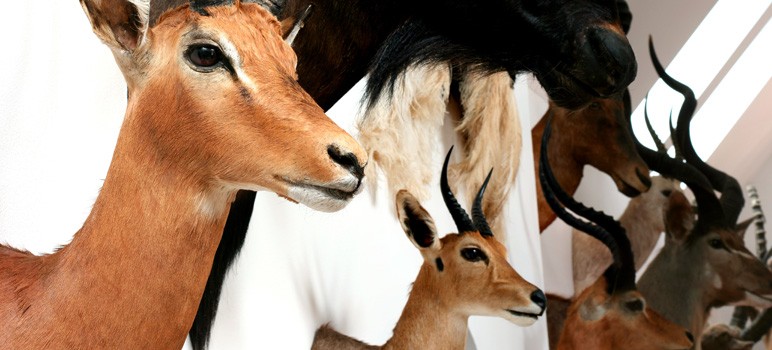Max Schad received an unusual email last summer. A French investigator claimed to have information that someone in San Jose was using eBay to purchase an endangered—and taxidermied—species of owl from France. As fish and game warden for California’s Department of Fish and Wildlife, Schad gets a lot of tips about people illegally buying and selling wildlife. He doesn’t have nearly enough time to pursue every lead.
But this case was different. Not only was it a violation of state and federal law, because this particular owl was part of a protected species—it was also a violation of an international treaty to protect endangered plants and animals.
The only information the French investigator could provide was a P.O. Box in San Jose. Schad reached out to the postal inspector to locate the woman who wanted the rare dead birds. “I got an address that ended up being the wrong address,” he says, “and we basically spent a couple of months chasing down addresses. I couldn’t find the person.”
But then he got a break. He spoke with one of her old landlords, who gave a description of a car the woman’s husband drove and mentioned they still lived on San Jose’s East Side.
“It was a pretty specific description—they had some things done to [the car]—so it was easy to find,” Schad says. “I ended up trolling the East Side for a little while, and I ended up finding the vehicle parked in an apartment complex. Through the plate I was able to get the correct address. We made contact at the door, she invited us in, and then we found all these critters mounted inside her apartment.”
What he found inside was unlike anything else he had ever seen: “There had to have been about 50 animals or something—everything from a huge African lion to smaller lizards,” Schad says. “It was pretty impressive.”
The suspect, Dora Martha Jimenez Zepeda, admitted to collecting mounted animals—a hobby of sorts—and said she bought most of them online. She pleaded no contest in March to unlawful possession of birds of prey, resulting in a $3,600 fine, 300 hours of community service, three years of probation and the kicker—relinquishing her many taxidermied animals.
Wildlife is one of the biggest illegal trades in the world, with some estimating the amount of transactions at nearly $20 billion. Adam Roberts, CEO of the animal advocacy group Born Free USA, says animal trafficking is “up there with drug trafficking and human trafficking in terms of illegal activity and profitability.”
Rhinoceros horns run about $90,000 per kilogram, Roberts says, making a single horn worth up to half a million dollars. Meanwhile, elephant ivory is $2,000 per kilogram. These high prices have led to the widespread killing of animals for their parts, and the decimation of certain species. In the 1970s and 1980s, for example, the African elephant population plummeted was cut in more than half, from 1.3 million to about 600,000.
California, in particular, is a major poaching site. Given its proximity to Asian markets, the state acts as a hub for imports and exports. California’s black bears, which are hunted across the state for their bile and gallbladders, have been in especially high demand, Roberts says. They are shipped abroad and around the country to be used as ingredients in traditional Asian medicines and high-end shampoos and cosmetics. “You would find bears in the woods that were killed with their abdomen sliced open and their gall bladder taken out,” he says.
While statistics on how many black bears are being killed every year are lacking, Roberts has concerns about how quickly the animal population could disappear. “In 1900, there were a hundred thousand tigers, and now there’s somewhere between three and four thousand,” Roberts says. “So we know in the course of one century what can happen to a wildlife population, if there’s significant pressure to kill them for their parts. And bears would not be immune.”
Elly Pepper, a policy advocate for the land and wildlife program at the Natural Resources Defense Council, says California is also a national hub for ivory trade. “It’s the second-largest retail market, with San Francisco and Los Angeles as its epicenters,” she says.
Current California law prohibits the importation, sale and purchase of ivory, with one big exception—not if it’s older than 38 years. Pepper refers to this clause as the “pre-1977 loophole.” According to a 2015 NRDC analysis, approximately 80 percent of ivory sold in San Francisco is illegal under this law. But determining the exact age of ivory is nearly impossible without DNA analysis or carbon dating, so new ivory easily slips onto the market.
“California is saying that old ivory is okay, new ivory is not—but we can’t tell the difference,” says Pepper. She estimates 100,000 elephants were killed by poachers in Africa between 2012 and 2012. “Basically, permitting a legal trade in old ivory serves as a cover to facilitate the illegal market of ivory from recently killed elephants.”
The NRDC is now sponsoring AB 96, which would make all ivory transactions illegal, regardless of age. (Californians can keep ivory antiques they already have, and ivory could be transferred to legal heirs.) Instead of a fine of up to $5,000 and up to six months in jail, offenders would be required to pay $50,000 or two times the amount of the contraband—whichever is greater—and up to a year in jail.
This term of incarceration is more than the typical term for disturbing the peace or misdemeanor battery, says J.J. Kapp, acting assistant public defender for Santa Clara County, but similar to what many people get for driving under the influence.
“You can challenge someone to a fight and be charged with disturbing the peace and get 90 days,” Kapp says, “whereas someone selling ivory could get a year in county jail.”
Terry Anderson, distinguished senior fellow at the Property and Environment Research Center, argues that criminalization of the wildlife trade has been “totally ineffective.” Instead he advocates regulation over bans and penalties.
“I would liken it to our drug laws and the drug trade and ask how we’ve done with that,” he says.
Even though Pepper is pushing for tougher regulations in California, she acknowledges that the state already has more robust rules than elsewhere in the country. Many states simply relying on federal law, such as the Endangered Species Act.
For instance, California bans the possession of any part of an endangered bird of prey—including feathers—as well as the importing of elk antlers. Residents are explicitly prohibited from owning sloths, anteaters, platypuses, lemurs, bats, aardvarks, elephants and manatees. Any animal part that is native to California is also barred from sale, even if it was acquired in another state.
Despite these strict regulations, there is the lack of bodies to enforce the laws. Kapp says that in his 25 years as an attorney, he’s only seen one exotic animal case. And despite the frequent tips Schad receives, the fish and game warden only pursues four or five cases a year.
“It’s one of the many things we do, but it’s not something we have a lot of time to devote to up here,” Schad admits. “There’s plenty of work out there, it’s just the manpower that’s definitely lacking.”
- The illegal trafficking of rare and endangered animals has increased while manpower to police such activity is limited.
- These taxidermy animals were found in an East San Jose woman’s home. (Photos courtesy of California Department of Fish and Wildlife)
- These taxidermy animals were found in an East San Jose woman’s home. (Photos courtesy of California Department of Fish and Wildlife)
- These taxidermy animals were found in an East San Jose woman’s home. (Photos courtesy of California Department of Fish and Wildlife)






The state refuses to fund enough Fish and Wildlife warden positions. Nothing new here.
The State tends to reserve our money for the loudest and cleverest whiners.
The animals need to form a union.
Jesus Christ… It’s suspect to own Taxidermy animals now? Better not look in my great grandfathers house on McKee.
The first picture’s annotation doesn’t say if it was found in the womans home. Either way, they’re African Gazelles, very common. The next 3 pictures, I see all domestic animals. A few owls, pheasants, and a snake in the 2nd. An Iguana and an Egret in 3? #4 has a few hawks, some trout, and a squirrel.
Not all taxidermy is made from original animals. A common trend is to purchase a foam “Skeleton” then decorate. You can purchase the eyes, beaks, and claws separately. Some taxidermist use roadkill.
I guess this sort of bothers me because I grew up around my great grandfather. Hunting/Taxidermy was very much his thing. Even the Merc reported him heroically for killing a mountain lion on Mount Hamilton (which was proudly displayed above his fireplace mantle, along with a 1/2 dozen other animals)
I know hanging the effigy of dead animals around your house probably doesn’t appeal to your average non-cathlolic person, but we love it. Heck, we hang effigies of our lords son hanging from a cross all over.
Very disturbing article. It seems to always come back to money and greed doesn’t it? Sad~
There is a lesson in civilization here.
10,000 years ago, all humans lived in tribes and made their living as hunter-gathers in the forest. Anything in the forest was theirs for the taking. Other tribes found hunting in your forest were enemies, and maybe even a meal.
The invention of herding and agriculture created the concept of private property, which asserted the proposition that NOT ALL animals or crops were “fair game” for hunter-gathers.
Domesticated animals were “protected” by their owners because they were profitable.
But civilization also recognized the need to protect animals on “royal lands”, i.e. state property, for various reasons. Undoubtedly, the king and his counselors recognized the problem of overhunting and overfishing.
Modern technology made the necessity of protecting non-domestic fauna obvious and a clear responsibility of civilization.
If humanity looked the other way, a few hundred AK-47’s in the hands of the wrong people could wipe out all elephants, rhinos, tigers, etc. in very short order.
What civilization and the market system has done, is effectively to assign a value to rare species. And the institutions of civilization, e.g., the Fish and Game Department, exercises defacto ownship of such non-domestic species.
Bottom line, it is “civilization”, which is really a consequence of private property and capitalism, that ultimately protects rare species.
The notion that primitive peoples living close to nature care about rare species is mostly bogus narrative. The primitives regarded anything in the forest that was edible as a candidate for their next meal.
You’re right about the hunter gatherers not necessarily caring about preserving their own natural environment. So if we here in San Jose are at all interested in protecting animals in Africa then the civilized thing for us to do is to take care not to provide any incentive to killing them. That means not buying ivory- ANY ivory, letting your Chinese friends know how un-American they are for supporting the market for rhino horn powder, and enforcing penalties against those among us who purchase stuffed gazelles, elands, impalas. and springboks.
> So if we here in San Jose are at all interested in protecting animals in Africa then the civilized thing for us to do is to take care not to provide any incentive to killing them.
> That means not buying ivory- . .. .
Bingo!
Civilization at work.
I learned this from Ron Paul.
Its particularly important for libertarians to understand this, because they think that the free market means “sell anything to anybody at anytime”.
Libertarianism gets a bad rap. It’s widely understood that liberals and conservatives come in varying degrees but libertarians are assumed to be inflexible extremists- and maybe they usually are. But that’s no reason to dismiss such a powerful and useful philosophy.
> Libertarianism gets a bad rap.
I agree.
I regard myself as a small “L” libertarian.
The folly of SOME libertarians is that they imagine they can calculate political virtue by exercises of pure reason.
Reason tells them that unrestrained drug use is a good thing because it’s “freedom”.
Reason tells me that science doesn’t know most of the long term destructive effects of most drugs, and blowing out your liver is not worth a hallucigenic fantasy.
Sometimes, you have to take into account other people’s experiences in addition to pure reason.
You and I are generally on the same page.
But people ought to have the freedom to take chances and suffer the consequences when they miscalculate. In my version of libertarianism people would be free to engage in any self destructive activities- including taking drugs. On the other hand it makes me snort to hear some of these potheads describe themselves as “libertarian”. Though philosophically in favor of it, drug decriminalization is not a top priority in my world because it’d mostly be to benefit a slothful, morally bankrupt class of people who are only too happy to leech off entitlement giveaways thus depriving their fellow citizens of their money and the time they spent earning it. The legalization movement, as it is presently evolving, is anything but a movement toward Liberty.
So as you can see, my Libertarian leanings can be moderated, especially when it comes to dealing with animals- including the two legged variety!